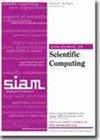An Entropy Stable Essentially Oscillation-Free Discontinuous Galerkin Method for Hyperbolic Conservation Laws
IF 2.6
2区 数学
Q1 MATHEMATICS, APPLIED
引用次数: 0
Abstract
SIAM Journal on Scientific Computing, Volume 46, Issue 2, Page A1132-A1159, April 2024.Abstract. Entropy inequalities are crucial to the well-posedness of hyperbolic conservation laws, which help to select the physically meaningful one from among the infinite many weak solutions. Recently, several high order discontinuous Galerkin (DG) methods satisfying entropy inequalities were proposed; see [T. Chen and C.-W. Shu, J. Comput. Phys., 345 (2017), pp. 427–461; J. Chan, J. Comput. Phys., 362 (2018), pp. 346–374; T. Chen and C.-W. Shu, CSIAM Trans. Appl. Math., 1 (2020), pp. 1–52] and the references therein. However, high order numerical methods typically generate spurious oscillations in the presence of shock discontinuities. In this paper, we construct a high order entropy stable essentially oscillation-free DG (OFDG) method for hyperbolic conservation laws. With some suitable modification on the high order damping term introduced in [J. Lu, Y. Liu, and C.-W. Shu, SIAM J. Numer. Anal., 59 (2021), pp. 1299–1324; Y. Liu, J. Lu, and C.-W. Shu, SIAM J. Sci. Comput., 44 (2022), pp. A230–A259], we are able to construct an OFDG scheme with dissipative entropy. It is challenging to make the damping term compatible with the current entropy stable DG framework, that is, the damping term should be dissipative for any given entropy function without compromising high order accuracy. The key ingredient is to utilize the convexity of the entropy function and the orthogonality of the projection. Then the proposed method maintains the same properties of conservation, error estimates, and entropy dissipation as the original entropy stable DG method. Extensive numerical experiments are presented to validate the theoretical findings and the capability of controlling spurious oscillations of the proposed algorithm.
双曲守恒定律的熵稳定基本无振荡非连续伽勒金方法
SIAM 科学计算期刊》,第 46 卷第 2 期,第 A1132-A1159 页,2024 年 4 月。 摘要熵不等式是双曲守恒律好求解的关键,它有助于从无限多的弱解中选择有物理意义的解。最近提出了几种满足熵不等式的高阶非连续伽勒金 (DG) 方法;见 [T. Chen and C.-W.Chen and C.-W. Shu, J. Comput.Shu, J. Comput.Phys., 345 (2017), pp.Phys., 362 (2018), pp.Shu, CSIAM Trans.Appl. Math., 1 (2020), pp.然而,高阶数值方法通常会在冲击不连续的情况下产生假振荡。本文构建了双曲守恒定律的高阶熵稳定本质无振荡 DG(OFDG)方法。通过对 [J. Lu, Y. Liu, and C. M.] 中引入的高阶阻尼项进行一些适当的修正,我们可以得到一个高阶熵稳定的双曲守恒律本质无振荡 DG(OFDG)方法。Lu、Y. Liu 和 C.-W. Shu, SIAM J. N.Shu, SIAM J. Numer.Anal., 59 (2021), pp.Shu, SIAM J. Sci. Comput.如何使阻尼项与当前的熵稳定 DG 框架兼容是一个挑战,也就是说,对于任何给定的熵函数,阻尼项都应该是耗散的,同时不影响高阶精度。关键是利用熵函数的凸性和投影的正交性。这样,所提出的方法就能保持与原始熵稳定 DG 方法相同的守恒、误差估计和熵耗散特性。大量的数值实验验证了所提算法的理论结论和控制杂散振荡的能力。
本文章由计算机程序翻译,如有差异,请以英文原文为准。
求助全文
约1分钟内获得全文
求助全文
来源期刊
CiteScore
5.50
自引率
3.20%
发文量
209
审稿时长
1 months
期刊介绍:
The purpose of SIAM Journal on Scientific Computing (SISC) is to advance computational methods for solving scientific and engineering problems.
SISC papers are classified into three categories:
1. Methods and Algorithms for Scientific Computing: Papers in this category may include theoretical analysis, provided that the relevance to applications in science and engineering is demonstrated. They should contain meaningful computational results and theoretical results or strong heuristics supporting the performance of new algorithms.
2. Computational Methods in Science and Engineering: Papers in this section will typically describe novel methodologies for solving a specific problem in computational science or engineering. They should contain enough information about the application to orient other computational scientists but should omit details of interest mainly to the applications specialist.
3. Software and High-Performance Computing: Papers in this category should concern the novel design and development of computational methods and high-quality software, parallel algorithms, high-performance computing issues, new architectures, data analysis, or visualization. The primary focus should be on computational methods that have potentially large impact for an important class of scientific or engineering problems.

 求助内容:
求助内容: 应助结果提醒方式:
应助结果提醒方式:


